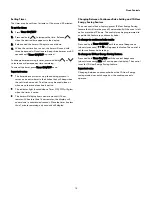
9
Before Setting Surface Controls
Using proper cookware
Check for flatness by rotating a straight-edged ruler across the
bottom of the cookware (see
Figure 2
). Cookware should have
flat bottoms that make good contact with the entire surface
heating element (see
Figure 3
).
Cookware Material Types
The cookware material determines how evenly and quickly heat
is transferred from the surface element to the pan bottom. The
most popular materials available are:
Aluminum - Excellent heat conductor. Some types of food will
cause it to darken (Anodized aluminum cookware resists staining
and pitting).
Copper - Excellent heat conductor but discolors easily (see
Aluminum).
Stainless - Slow heat conductor with uneven cooking results. Is
durable, easy to clean and resists staining.
Cast Iron - A slow heat conductor however will retain heat very
well. Cooks evenly once cooking temperature is reached.
Porcelain-enamel on metal - Heating characteristics will vary
depending on base material.
Glass - Slow heat conductor.
About the surface elements
The element temperature rises gradually and evenly. As the
temperature rises, the element will glow red. For efficient
cooking, turn off the surface element just before cooking is
complete. This will allow residual heat to complete the cooking
process.
Surface elements may appear to have cooled
after they have been turned off. The surface element may still
be hot and burns may occur if the surface element is touched
before it has cooled sufficiently.
Do not place plastic items such as salt and
pepper shakers, spoon holders or plastic wrappings on top of
the range when it is in use. These items could melt or ignite.
Potholders, towels or wooden spoons could catch fire if placed
too close to the surface elements.
Do not use aluminum foil to line surface unit
drip bowls, or reflector pans. Only use aluminum foil as recom-
mended in this manual. Improper installation of these liners may
result in risk of electric shock, or fire.
Do not place aluminum foil or any material that could melt on
the surface elements.
Make sure reflector pans or drip bowls are in place —Absence
of these pans or bowls during cooking may subject wiring or
components underneath to damage.
The size and type of cookware
used will influence the radiant ele-
ment power level setting needed
for best cooking results. Be sure to
follow the recommendations for
using proper cookware as illus-
trated in both
Figure 2
and
Figure 3
.
Figure 2: Testing cookware
Figure 3: Proper cookware placement
• Flat bottom and straight
sides.
• Tight fitting lids.
• Weight of handle does
not tilt pan. Pan is well
balanced
.
• Pan sizes match the
amount of food to be
prepared and the size
of the surface element.
• Made of material that
conducts heat well.
• Easy to clean.
• Always match pot
diameter to element
size.
• Curved and warped pans.
• Cookware larger than
cooking area marked on
cooktop by more than
one-half inch or 12mm.
• Heavy handle tilts pan.
• Pan is smaller than the
heating area marked on
cooktop.










































